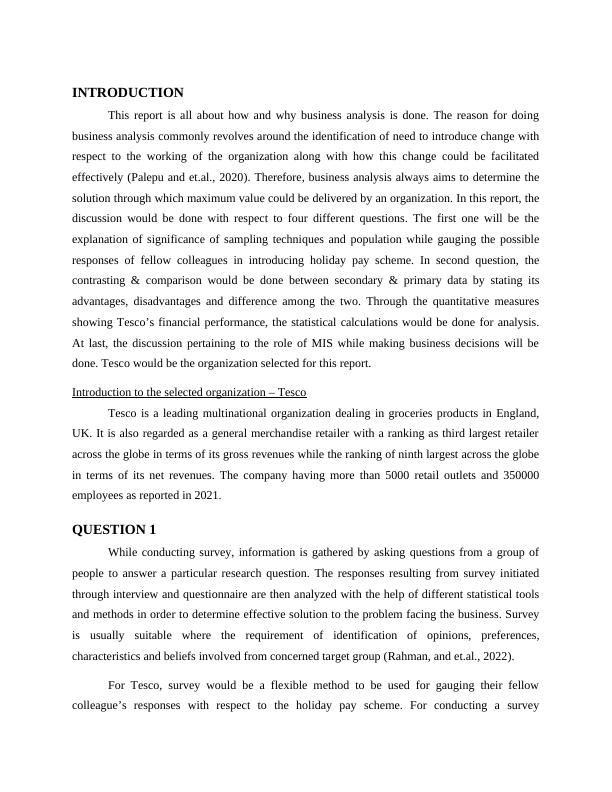Business Analysis for Tesco: Sampling Techniques, Primary and Secondary Data
Added on 2023-06-07
20 Pages5589 Words62 Views
BUSINESS ANALYSIS

Table of Contents
INTRODUCTION...........................................................................................................................3
Introduction to the selected organization – Tesco.......................................................................3
QUESTION 1..................................................................................................................................3
QUESTION 2..................................................................................................................................6
Primary data & Secondary data...................................................................................................6
QUESTION 3................................................................................................................................11
QUESTION 4................................................................................................................................13
CONCLUSION..............................................................................................................................16
REFERENCES..............................................................................................................................17
Books and Journals....................................................................................................................17
INTRODUCTION...........................................................................................................................3
Introduction to the selected organization – Tesco.......................................................................3
QUESTION 1..................................................................................................................................3
QUESTION 2..................................................................................................................................6
Primary data & Secondary data...................................................................................................6
QUESTION 3................................................................................................................................11
QUESTION 4................................................................................................................................13
CONCLUSION..............................................................................................................................16
REFERENCES..............................................................................................................................17
Books and Journals....................................................................................................................17

INTRODUCTION
This report is all about how and why business analysis is done. The reason for doing
business analysis commonly revolves around the identification of need to introduce change with
respect to the working of the organization along with how this change could be facilitated
effectively (Palepu and et.al., 2020). Therefore, business analysis always aims to determine the
solution through which maximum value could be delivered by an organization. In this report, the
discussion would be done with respect to four different questions. The first one will be the
explanation of significance of sampling techniques and population while gauging the possible
responses of fellow colleagues in introducing holiday pay scheme. In second question, the
contrasting & comparison would be done between secondary & primary data by stating its
advantages, disadvantages and difference among the two. Through the quantitative measures
showing Tesco’s financial performance, the statistical calculations would be done for analysis.
At last, the discussion pertaining to the role of MIS while making business decisions will be
done. Tesco would be the organization selected for this report.
Introduction to the selected organization – Tesco
Tesco is a leading multinational organization dealing in groceries products in England,
UK. It is also regarded as a general merchandise retailer with a ranking as third largest retailer
across the globe in terms of its gross revenues while the ranking of ninth largest across the globe
in terms of its net revenues. The company having more than 5000 retail outlets and 350000
employees as reported in 2021.
QUESTION 1
While conducting survey, information is gathered by asking questions from a group of
people to answer a particular research question. The responses resulting from survey initiated
through interview and questionnaire are then analyzed with the help of different statistical tools
and methods in order to determine effective solution to the problem facing the business. Survey
is usually suitable where the requirement of identification of opinions, preferences,
characteristics and beliefs involved from concerned target group (Rahman, and et.al., 2022).
For Tesco, survey would be a flexible method to be used for gauging their fellow
colleague’s responses with respect to the holiday pay scheme. For conducting a survey
This report is all about how and why business analysis is done. The reason for doing
business analysis commonly revolves around the identification of need to introduce change with
respect to the working of the organization along with how this change could be facilitated
effectively (Palepu and et.al., 2020). Therefore, business analysis always aims to determine the
solution through which maximum value could be delivered by an organization. In this report, the
discussion would be done with respect to four different questions. The first one will be the
explanation of significance of sampling techniques and population while gauging the possible
responses of fellow colleagues in introducing holiday pay scheme. In second question, the
contrasting & comparison would be done between secondary & primary data by stating its
advantages, disadvantages and difference among the two. Through the quantitative measures
showing Tesco’s financial performance, the statistical calculations would be done for analysis.
At last, the discussion pertaining to the role of MIS while making business decisions will be
done. Tesco would be the organization selected for this report.
Introduction to the selected organization – Tesco
Tesco is a leading multinational organization dealing in groceries products in England,
UK. It is also regarded as a general merchandise retailer with a ranking as third largest retailer
across the globe in terms of its gross revenues while the ranking of ninth largest across the globe
in terms of its net revenues. The company having more than 5000 retail outlets and 350000
employees as reported in 2021.
QUESTION 1
While conducting survey, information is gathered by asking questions from a group of
people to answer a particular research question. The responses resulting from survey initiated
through interview and questionnaire are then analyzed with the help of different statistical tools
and methods in order to determine effective solution to the problem facing the business. Survey
is usually suitable where the requirement of identification of opinions, preferences,
characteristics and beliefs involved from concerned target group (Rahman, and et.al., 2022).
For Tesco, survey would be a flexible method to be used for gauging their fellow
colleague’s responses with respect to the holiday pay scheme. For conducting a survey

successfully, researcher is required to go through with six steps to make sure that they have
accomplished their objective underpinning the research of what would be the reaction of fellow
colleagues with respect to the implementation of holiday pay scheme (Lee and Spratling, 2019).
These steps involve identification of potential survey participants, determination of the mode of
survey that is, online or offline, setting questions to be requested from the participants, getting
participant’s response either through questionnaire or interview, conducting analysis and
drawing results from the responses. All these steps must be followed consciously by Tesco in
order to effectively gauge their colleague’s responses prior to the implementation of changes in
policies related to work culture. This is because such policies & schemes like holiday pay
scheme pay great effect the employee’s productivity and accordingly, the overall organizational
performance gets affected.
Therefore, it must be kept in mind that for effective survey, enough focus should be given
with respect to the sampling technique and population.
Population
Population of the survey means that particular group of people about whom the
researcher wants to determine something or solve any of their issue or problem (Pedigo, 2020).
In other words, they are regarded as potential survey participants from whom the information
meant for addressing the stated research issue can be obtained. It must be kept in mind while
conducting a survey that population includes all those individuals about whom the surveyor is
going to draw some conclusion. As population involves a very large group of people, sampling is
done for selecting limited number of individuals who participate in the survey and give their
responses. This is because of the constraints related to time & budget which do not allow
surveyor to get responses from each and every individual who are part of the entire population.
Accordingly, the size of population is always larger than the size of sample. With respect to
Tesco, all the fellow colleagues would be regarded as the population of the survey as
implementation of holiday pay scheme would be going to affect all of them. In statistics,
population is defined as the pool of individual out of which the statistical sample is formed for
conducting research. Commonly, too many individuals are studied for drawing conclusions
reliably and conveniently.
accomplished their objective underpinning the research of what would be the reaction of fellow
colleagues with respect to the implementation of holiday pay scheme (Lee and Spratling, 2019).
These steps involve identification of potential survey participants, determination of the mode of
survey that is, online or offline, setting questions to be requested from the participants, getting
participant’s response either through questionnaire or interview, conducting analysis and
drawing results from the responses. All these steps must be followed consciously by Tesco in
order to effectively gauge their colleague’s responses prior to the implementation of changes in
policies related to work culture. This is because such policies & schemes like holiday pay
scheme pay great effect the employee’s productivity and accordingly, the overall organizational
performance gets affected.
Therefore, it must be kept in mind that for effective survey, enough focus should be given
with respect to the sampling technique and population.
Population
Population of the survey means that particular group of people about whom the
researcher wants to determine something or solve any of their issue or problem (Pedigo, 2020).
In other words, they are regarded as potential survey participants from whom the information
meant for addressing the stated research issue can be obtained. It must be kept in mind while
conducting a survey that population includes all those individuals about whom the surveyor is
going to draw some conclusion. As population involves a very large group of people, sampling is
done for selecting limited number of individuals who participate in the survey and give their
responses. This is because of the constraints related to time & budget which do not allow
surveyor to get responses from each and every individual who are part of the entire population.
Accordingly, the size of population is always larger than the size of sample. With respect to
Tesco, all the fellow colleagues would be regarded as the population of the survey as
implementation of holiday pay scheme would be going to affect all of them. In statistics,
population is defined as the pool of individual out of which the statistical sample is formed for
conducting research. Commonly, too many individuals are studied for drawing conclusions
reliably and conveniently.

End of preview
Want to access all the pages? Upload your documents or become a member.
Related Documents
Significance of Population and Sampling in Business Analysislg...
|14
|4577
|336
DISSERTATION. Acknowledgement. I would like to thank. mlg...
|47
|13858
|143
Significance of Population and Sampling Techniques in Business Analysislg...
|8
|2386
|33
Significance of Population and Sampling Techniques in Business Analysislg...
|14
|5204
|68
Business Feasibility Analysislg...
|26
|3595
|79
Business Analysislg...
|14
|4550
|21
